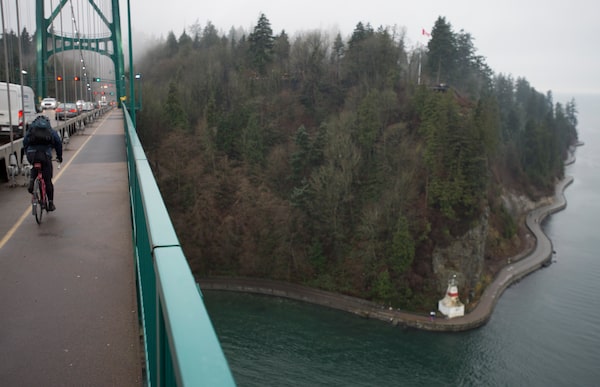
A cyclist rides their bike over the Lions Gate Bride in Stanley Park in downtown Vancouver, on Dec. 30, 2019.JONATHAN HAYWARD/The Canadian Press
Vancouver is moving to restrict car traffic through Stanley Park and offering up one of the two road lanes exclusively to cyclists, an experiment that has prompted a debate about whether the move will make the park less accessible to elderly, disabled and family visitors.
Proponents say the move will actually allow more people, not just those with access to cars, to use the iconic park, which already gets up to 10 million visitors a year.
The downtown park was closed to car traffic in the early days of the COVID-19 pandemic to give cyclists space after they were banned from the seawall, which suddenly filled up with pedestrians. Vancouver Park Board staff will now explore “the long-term feasibility of reducing motor vehicle traffic” after board commissioners voted 5-2 in favour of that idea Monday.
In the meantime, the park road will be reconfigured in the coming weeks to launch the experiment even before staff start studying the concept or issue a report.
One lane will be reopened to cars, while the second will be physically blocked off for other wheeled forms of transportation.
Many cities around the world closed or restricted car traffic in their parks during the first couple of months of the COVID-19 restrictions. But none have made that permanent, as far as parks commissioner John Irwin knows, except perhaps on a weekend basis.
But Mr. Irwin, who co-proposed the idea, firmly believes it’s worth trying.
“I’m finding it a bit frustrating that the discourse has been that people are losing something. I think it’s going to work out. I know when I rode it with my kids, I love not having to look back or ahead to make sure they’re safe.”
Anywhere from 5,300 to 9,500 cyclists a day rode in the park while the road was closed.
But there are many who don’t agree with the change, including Linda Launey, a retired applications analyst who lives in suburban Surrey, B.C.
“If we have company come from out of town, we take them to the park. Many are elderly and can’t walk. What they’re doing here is making it more of a really nice park just for the locals that live there,” she said.
Non-Partisan Association party park commissioner Tricia Barker also made a passionate case at a virtual meeting Monday that many disabled or elderly people will be hindered if they try to go, as will families who want to have a picnic with their children.
The two-lane road is often busy on summer weekends, with up to 2,500 vehicles, including tour buses and horse-drawn carriages. Now, half of the space will go to cyclists.
“You’re closing off a lane of traffic, but are there enough of those people?”
But the debate about the park’s accessibility also prompted some to point out that Stanley Park has not been very user-friendly for some. Disability advocate Gabrielle Peters observed in her Twitter comments during the debate that the park is often problematic, and has been for years, with its lack of curb cuts or ramps where there are changes in levels or its gravel paths.
The commissioners added requirements to the study that changes to the park also include improvements for those with disabilities or mobility impairments.
We have a weekly Western Canada newsletter written by our B.C. and Alberta bureau chiefs, providing a comprehensive package of the news you need to know about the region and its place in the issues facing Canada. Sign up today.